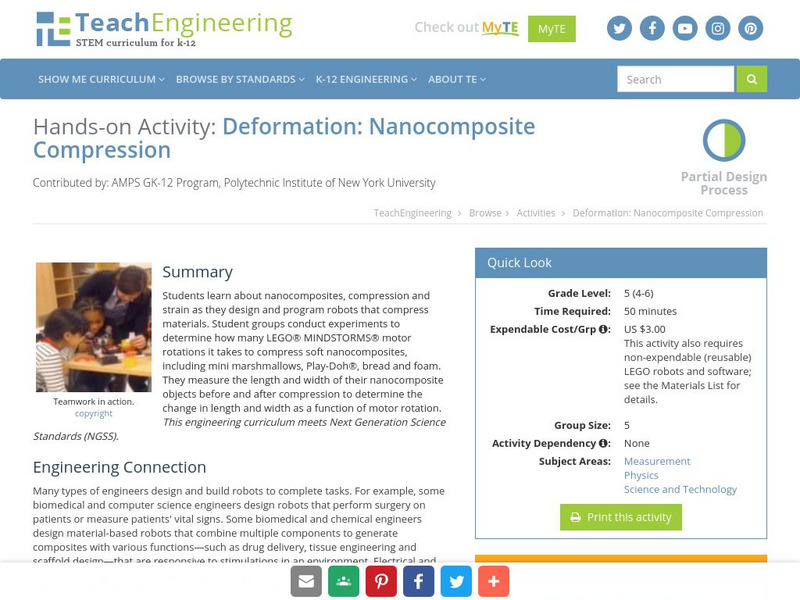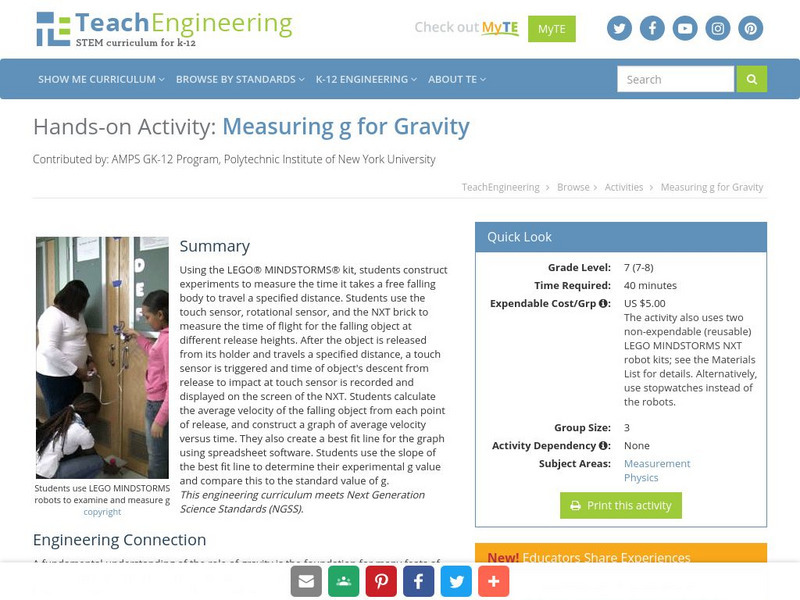Curated OER
Adjective Lesson Plan
Young scholars view a PowerPoint to introduce them to adjectives and complete a quiz. In groups, they travel between stations in which they work individually to correctly identify the adjectives in a sentence. They also create a list...
Curated OER
My How Things Have Changed
Eighth graders discuss the impact geography had on hunter-gatherer societies, their toolmaking. They work in groups to create a Web page that links pictures of artifacts to explanations about what the artifact tell us about the lives of...
Curated OER
Campaign Hot Buttons
Students participate in a simulation that asks them to work as staffers for a candidate running for office. They are assigned to design, administer, and analyze a simple poll on an important community issue. Students develop a position...
Curated OER
What Is Hot?
Students explore why: Schools are hotbeds of popular young opinion about what to wear, which music to listen to, and what TV shows to watch. In this activity, students extend their fascination with "what's hot" to the books they read by...
Curated OER
Assessment and Evaluation
Students model creating level appropriate lesson plans. Using a matrix, students develop a lesson plan with various technological resources. Students videotape their presentation and write a self narrative reflection evaluation.
Curated OER
Timelinging The Start of America
Students engage in a lesson that covers the history of America from its beginnings. They create a timeline of the events covered in chronological order. The lesson also includes a timeline quiz that is saved in a Microsoft Word document.
Curated OER
Probability
Fourth graders predict future outcomes with an investigation of the mathematical principle of probability using spinners constructed by them. The spinner is a hands on application an they combine it with writing a ratio for the...
Curated OER
Perimeter and Area
Sixth graders explore the relationship between area and perimeter of rectangles. In this area and perimeter activity, 6th graders measure and determine perimeter and area of various rectangles. Students create rectangles with given areas...
Curated OER
Reading
Third graders read more trade books. They increase difficulty level of trade books read. Students read chapter books. They read nonfiction selections. Students take a test over each book on Accelerated Reader.
Curated OER
Memory Book - A Cooperative Learning Experience
Learners document sections of their life through pictures, stories, and video to create an English "memory book". They use photographs, video and edited video which includes their history, includes calculated growth, and genetic...
Curated OER
Candy Land Math
Pupils order numbers and sets of objects from 0 through 10 and organize and interpret information collected from the immediate environment. They read and interpret graphs usin real objects and the computer. Finally, students sort a...
Other
Robelle: How to Debug a Program
Tips and suggestions for debugging software programs are offered for users of HP3000 and HP-UX.
Other
The History of Programming Languages
Brief history of programming languages is provided in this research paper at this site.
Wikimedia
Wikipedia: Pair Programming
A Wikipedia description of the software project development approach known as pair programming.
Wikimedia
Wikipedia: Programming Style
A Wikipedia description of what constitutes good programming style.
Other
Carnegie Mellon University: Alice V2.0
Learn how to program with Alice v2.0! Utilizing easy-to-learn drag-and-drop methods, Alice provides a wonderful introduction to programming methods. Create 3D graphics, a video game, a movie, or other interactive environment!
TeachEngineering
Teach Engineering: Deformation: Nanocomposite Compression
Students learn about nanocomposites, compression and strain as they design and program robots that compress materials. Student groups conduct experiments to determine how many LEGO MINDSTORMS NXT motor rotations it takes to compress soft...
TeachEngineering
Teach Engineering: Friction Force
Students use LEGO MINDSTORMS robotics to help conceptualize and understand the force of friction. Specifically, they observe how different surfaces in contact result in different frictional forces. A LEGO robot is constructed to pull a...
TeachEngineering
Teach Engineering: Linear Equations Game
Students groups act as aerospace engineering teams competing to create linear equations to guide space shuttles safely through obstacles generated by a modeling game in level-based rounds. Each round provides a different configuration of...
TeachEngineering
Teach Engineering: Robo Clock
Students learn various topics associated with the circle through studying a clock. Topics include reading analog time, understanding the concept of rotation (clockwise vs. counter-clockwise), and identifying right angles and straight...
TeachEngineering
Teach Engineering: Robotic Perimeter
Students learn and practice how to find the perimeter of a polygonal shape. Using a ruler, they measure model rooms made of construction paper walls. They learn about other tools, such as a robot, that can help them take measurements....
TeachEngineering
Teach Engineering: Measuring G
Using the LEGO MINDSTORMS NXT kit, students construct experiments to measure the time it takes a free falling body to travel a specified distance. Students use the touch sensor, rotational sensor, and the NXT brick to measure the time of...
TeachEngineering
Teach Engineering: Wide World of Gears
In an interactive and game-like manner, students learn about the mechanical advantage that is offered by gears. By virtue of the activity's mechatronics presentation, students learn to study a mechanical system as a dynamic system under...
TeachEngineering
Teach Engineering: A Lego Introduction to Graphing
Students use a LEGO ball shooter to demonstrate and analyze the motion of a projectile through use of a line graph. This activity involves using a method of data organization and trend observation with respect to dynamic experimentation...

























